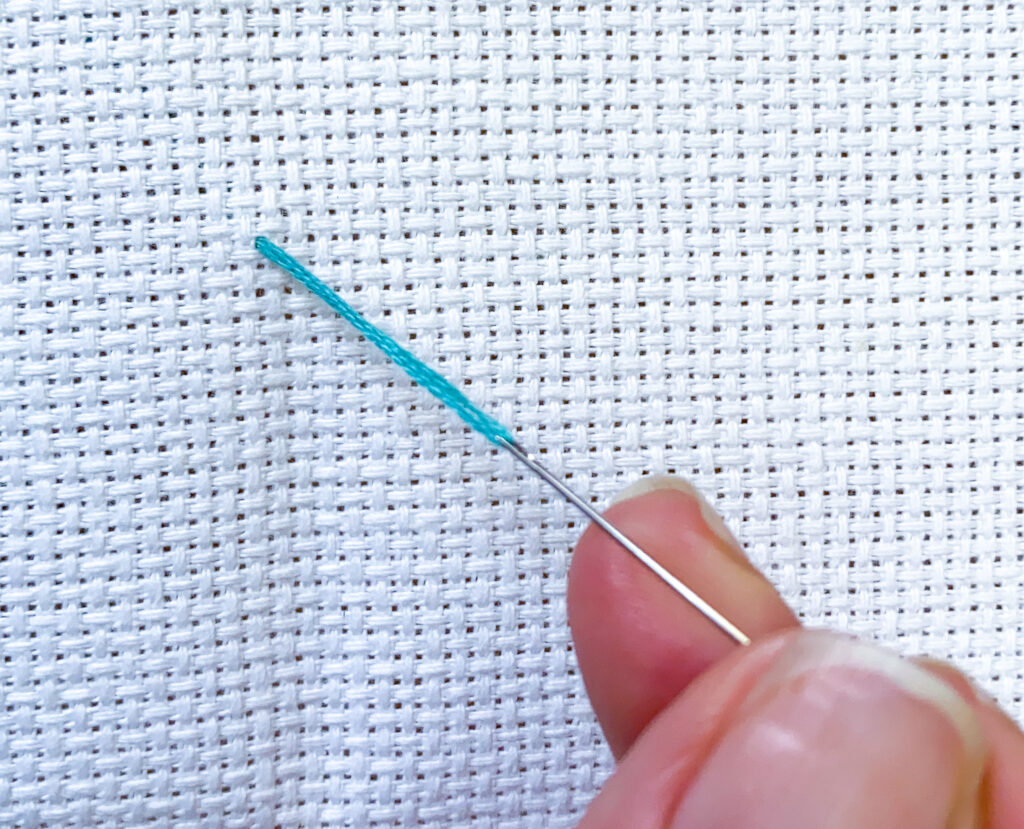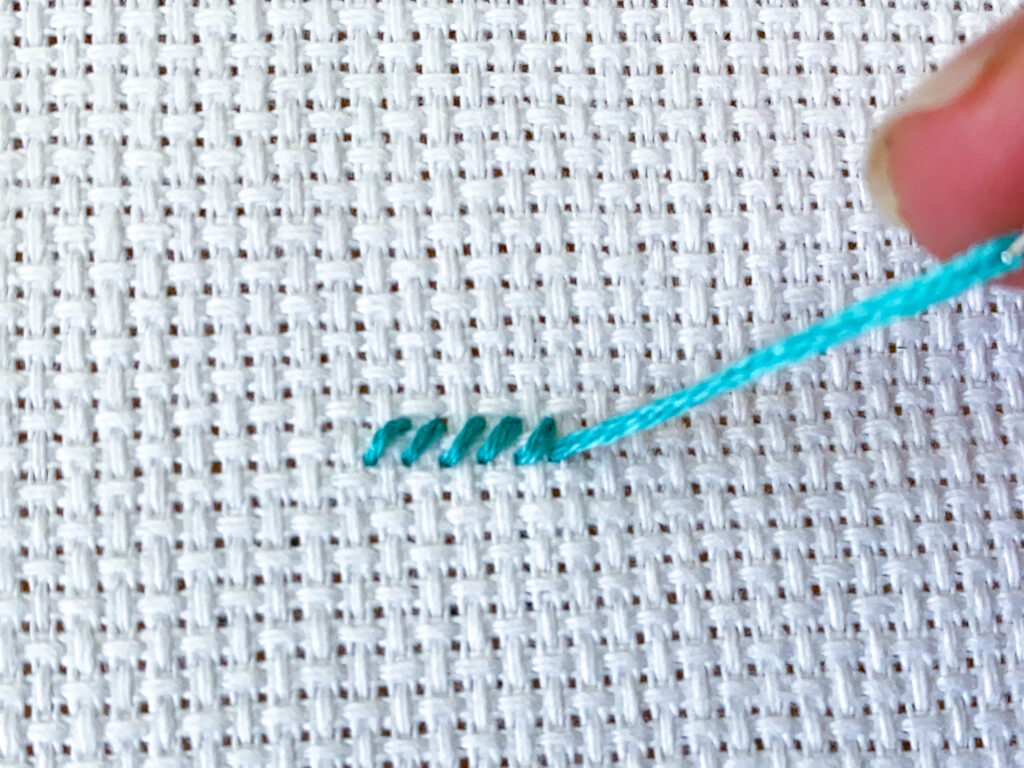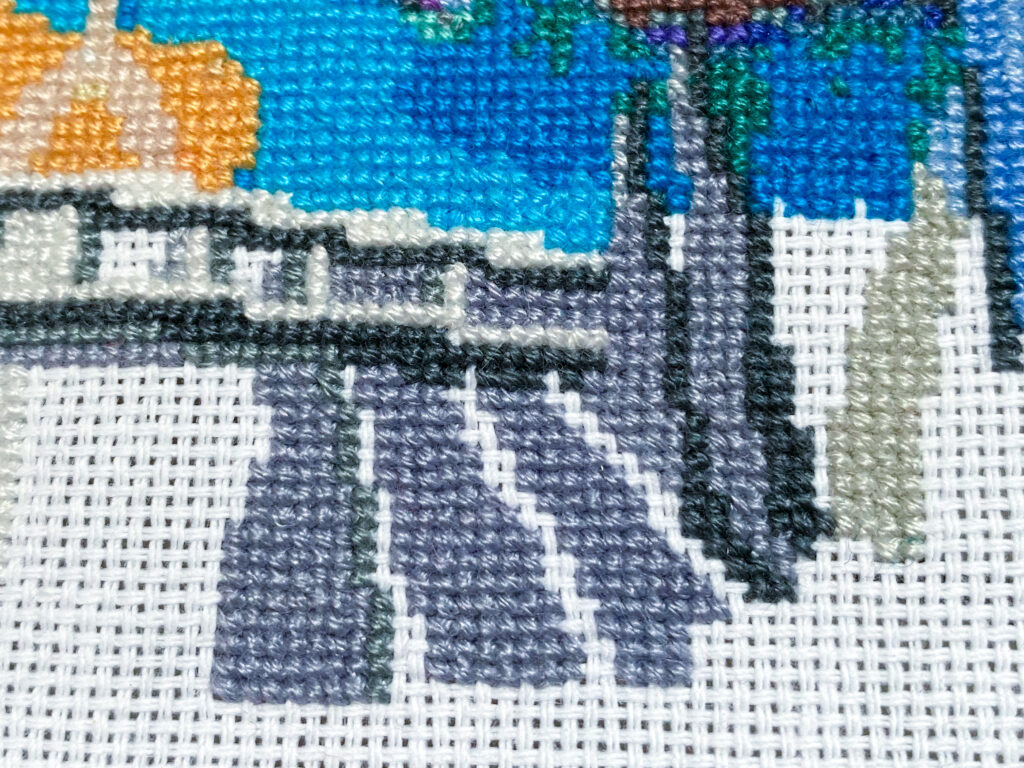Learn To Cross Stitch

First thing to know is that learning how to cross stitch is easy!
To start, gather your supplies.
Check out this post to see what you might need.
I like to tape the edges of my fabric to prevent any fraying.
Paper tape, masking tape, painters tape is the best type to use. Please do not use duct tape or regular office tape.
To start a project, it is best to start in the center. Trying to guess where the top, bottom, or sides will end never works out well.
Easiest way to start is in the middle.
Find the center of your fabric. Fold in half length-wise.

Then fold again by bringing the top and bottom edges together.

Pinch to mark the center of your fabric. After carefully unfolding, place a safety pin to mark the center.
Place fabric in frame.

Make sure you have the correct sized frame, that the pulled taught and even. The fabric should not be distorted. Pull too tight and you can destroy the fabric. At the same time there shouldn’t be a lot of slack. Go slowly.
Cut about an 18” long piece. Of course you can cut longer of shorted if you would like. Shorter and you will have to thread your needle more often – not fun. Longer and the thread tends to knot – also not fun. You don’t have to necessarily get out your ruler though. I measure from the tips of my fingers to the crook of my elbow. It’s not exactly 18’ but it is close enough.
Find the center of your pattern and choose the corresponding floss color. Separate into the number of strands indicated by the pattern and the size of fabric 2-3 strands is common. I am using three. When separating go slowly. If you pull to quickly the thread will become one big knot. Starting to sense a pattern?


Thread your needle. Be sure to keep one side only about ½ the length of the other. DO NOT KNOT! Knots and cross stitch are clearly not friends. There is no need to use knot son your cross-stitch projects. To secure thread, you can stitch over the tail. And when done with a color, pass the needle through stitches. Knots can cause lumps in your piece or block the way for your needle to pass.
Time to finally begin!
Think of a cross -stitch stitch as marking an X within a square, a hole denoting each corner. Start from the back side of our fabric in the lower left corner. Don’t pull the thread too quickly, you might pull it all the way through.

Once you have about a ¼ I” tail in the back hold it with one finger.

Insert needle into the upper right hole making a stitch slanted to the right. Again, don’t pull too quickly or tightly. The thread should rest, flat, against the fabric. Pull to tightly and you can distort the fabric. Your needle should now be at the back of our work.


Insert needle into the hole directly below the last one you used, and into the one diagonally up to the right. Repeat as many times as the pattern calls for. It should look something like this.

Now to complete the stitch. Do the same thing in the opposite direction. Always begin on the bottom hole and crossing over to the upper.




And that’s it! That is traditionally how it is stitched. HOWEVER…
When I make a mistake – which happens every so often – I find it difficult to undo a color without taking out the entire row. Enter – Rebel Cross Stitching. Instead of completing all the stitches leaning to the right and going back over with the stitches leaning left, I complete each X individually.
That way when I do make a mistake it is very easily removed. Do I make enough mistakes to justify this? No, not really. But I am also ridiculously impatient. I personally prefer to do it this way.
Here is a look at the back of a row traditionally stitched stitches on the bottom. And a row of my rebel cross stitching X’s on the top.

Clearly stitching in one direction at a time is much neater.
Here is a view from the front. The top was stitched each X individually. The next row was done stitching all left to right, then completing the stitches going from right to left. The lonely bottom stitch is to shoe what can happen when the floss is pulled too tightly.

Extra tips:
- Do not try to force thread through, it might be twisted and starting to form a knot (the enemy!), slow and check regularly. Let the needle dangle every once in a while, to let it untwist.
- Don’t pull too tight to ensure your stitches are even (See picture above.)
- You don’t have to do it row by row. You can continue in one color as long as the stitches are within close proximity. You don’t want to jump all the way across the fabric. Your thread might show through.

- Don’t forget to mark the stitches you’ve done so you never have to guess where to pick up.

Let us know how your project is going. Happy stitching!

woohoo!!! a new hyper fixation project with instructions both me and mini me can understand!!!
thank youuuuuuuuu!
You’re welcome! Enjoy learning a new skill with your little!